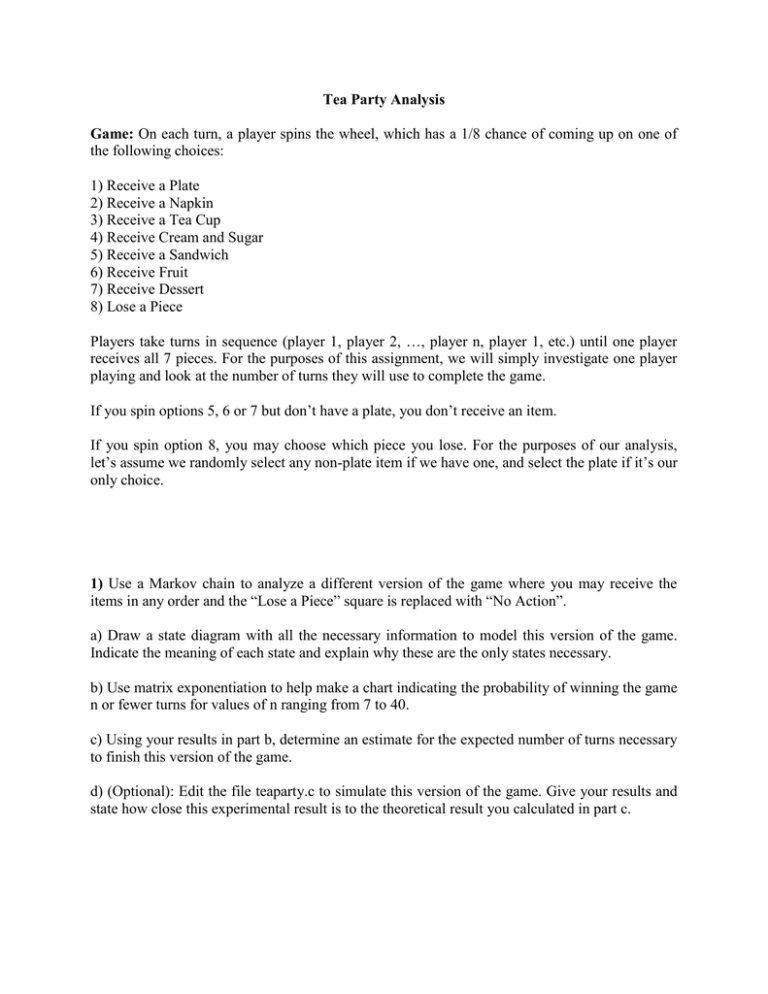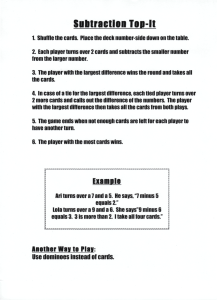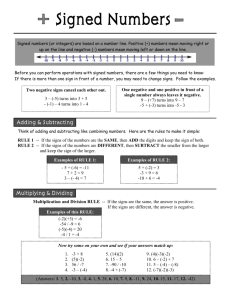Tea Party Analysis Game: the following choices:
advertisement

Tea Party Analysis Game: On each turn, a player spins the wheel, which has a 1/8 chance of coming up on one of the following choices: 1) Receive a Plate 2) Receive a Napkin 3) Receive a Tea Cup 4) Receive Cream and Sugar 5) Receive a Sandwich 6) Receive Fruit 7) Receive Dessert 8) Lose a Piece Players take turns in sequence (player 1, player 2, …, player n, player 1, etc.) until one player receives all 7 pieces. For the purposes of this assignment, we will simply investigate one player playing and look at the number of turns they will use to complete the game. If you spin options 5, 6 or 7 but don’t have a plate, you don’t receive an item. If you spin option 8, you may choose which piece you lose. For the purposes of our analysis, let’s assume we randomly select any non-plate item if we have one, and select the plate if it’s our only choice. 1) Use a Markov chain to analyze a different version of the game where you may receive the items in any order and the “Lose a Piece” square is replaced with “No Action”. a) Draw a state diagram with all the necessary information to model this version of the game. Indicate the meaning of each state and explain why these are the only states necessary. b) Use matrix exponentiation to help make a chart indicating the probability of winning the game n or fewer turns for values of n ranging from 7 to 40. c) Using your results in part b, determine an estimate for the expected number of turns necessary to finish this version of the game. d) (Optional): Edit the file teaparty.c to simulate this version of the game. Give your results and state how close this experimental result is to the theoretical result you calculated in part c. 2) Now, consider a version of the game where you may receive the pieces in any order, BUT, the “Lose a Piece” square forces you to lose a piece as previously defined. a) Draw a state diagram with all the necessary information to model this version of the game. Indicate the meaning of each state and explain why these are the only states necessary. b) Use matrix exponentiation to help make a chart indicating the probability of winning the game n or fewer turns for values of n ranging from 7 to 60. c) Using your results in part b, determine an estimate for the expected number of turns necessary to finish this version of the game. d) (Optional): Edit the file teaparty.c to simulate this version of the game. Give your results and state how close this experimental result is to the theoretical result you calculated in part c. 3) (OPTIONAL) Consider the actual version of the game and repeat the analysis from the previous parts (and printed below): a) Draw a state diagram with all the necessary information to model this version of the game. Indicate the meaning of each state and explain why these are the only states necessary. b) Use matrix exponentiation to help make a chart indicating the probability of winning the game n or fewer turns for values of n ranging from 7 to 150. c) Using your results in part b, determine an estimate for the expected number of turns necessary to finish this version of the game. d) Edit the file teaparty.c to simulate 1000000 games by one player and compare this to your theoretical result.



